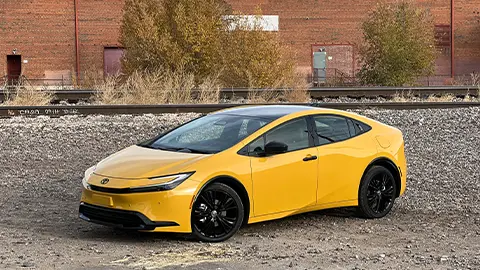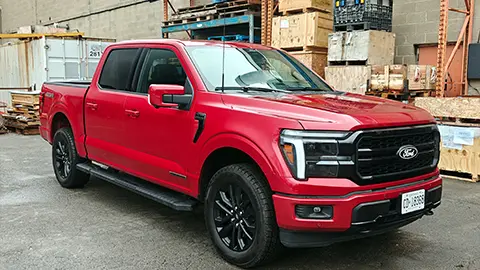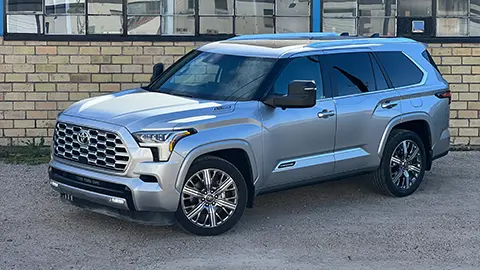The First Plug-In Hybrid SUV
More people are adding plug-in hybrids (PHEVs) to their shopping list as an introduction to the world of electrified vehicles. PHEVs are a great option if you’re concerned about range anxiety, charging, or if you do frequent road trips.
Mitsubishi is no stranger to PHEVs. In fact, it introduced the world’s first plug-in hybrid SUV over 10 years ago with the first-generation Outlander PHEV. In 2013, the Outlander PHEV was among the few plug-in hybrids available, along with the Chevrolet Volt, BMW i3 REx, and Ford C-Max.
The fourth-generation Outlander was introduced in 2023, and the plug-in version is the brand’s second-generation PHEV. Thanks to an alliance with Nissan, the current Mitsubishi Outlander is based on the Nissan Rogue, but it has Mitsubishi’s own design and hybrid powertrain.

Outlander PHEV EV Range and Powertrain
What really makes the Outlander PHEV stand out from its competitors is its hybrid powertrain. It’s a great example of how not all plug-in hybrids are created equal.
With a large 20kWh battery, the Outlander PHEV can travel on all-electric power up to 38 miles (or 61 km) on a full charge. The Kia Sorento PHEV can achieve almost as much, at up to 30 miles (48 km) on a much smaller 13.8kWh battery. With its 18.1-kWh battery, the Toyota RAV4 Prime is more efficient, delivering up to 42 miles (68 km). (All mileage is EPA estimated.)
Technically, the Outlander PHEV is a series-parallel hybrid like its competitors. This means that the gas engine and electric motor can work together to drive the wheels (series). Alternatively, either the electric motor(s) or gas engine alone can drive the wheels (parallel).
However, that’s where the similarities end. The way that the Outlander PHEV’s series-parallel hybrid system works is different. Once the battery has depleted, the Outlander PHEV mostly operates as a series hybrid; its 131-hp 2.4-liter 4-cylinder gasoline engine is used only to generate electricity for the battery and front and rear electric motors. Only the electric motors are used to drive the wheels. Only under very limited conditions and speeds is the gas engine used to drive the front wheels. Other plug-in hybrids, like the Toyota RAV4 Prime and Kia Sorento PHEV, use their gas engine frequently to drive the wheels with the assistance of the electric motors in hybrid mode.
What this means is that the Outlander PHEV drives more like a battery-electric vehicle than its competitors, even when the battery is depleted. The electric motors provide instant acceleration and more powerful regenerative braking. Indeed, you can think of the Outlander PHEV as a battery-electric vehicle with a backup gas generator.
While the Outlander PHEV’s system is a marvel of technology, it is not perfect. Since the gasoline engine primarily operates as a generator, it’s not the most efficient. The result is only an estimated EPA combined 26 mpg when in hybrid mode. Competitors like the RAV4 Prime will provide 38 mpg, and the Sorento PHEV will provide 34 mpg EPA combined. If you are doing mostly highway driving and road trips, the RAV4 Prime and Sorento PHEV are more efficient options.
It's worth noting that the gas engine, electric motors, and battery are covered by a class leading 10 year/100,000 mile warranty.
A PHEV with DC Fast Charging
Surprisingly, the Outlander PHEV’s onboard AC charger is only rated at 3.5 kW (about 15A) for Level 2 charging. Using a standard household 120V plug, or Level 1 charging, it will take about 16 hours to charge the Outlander PHEV to full from empty; using a Level 2 charger, it will take 6.5 hours. This is okay if you have a Level 2 home charger and can charge overnight. However, if you’re looking to maximize your all-electric driving on longer commutes and road trips, it will take a while to charge. It’s odd that Mitsubishi didn’t use a more powerful onboard charger for its bigger battery; by comparison, the Sorento PHEV will take 3.4 hours and the RAV4 Prime will take 4.5 hours to fully charge on a Level 2 charger.
The Outlander PHEV is one of two plug-in hybrids that can also charge on a Level 3 DC Fast Charger – the other being the Range Rover Sport PHEV. The Outlander PHEV can be equipped with a CHAdeMO connector on SEL trims and above.
While it’s great that Mitsubishi provides this charging option, there are two challenges with it. DC charging speed isn’t the fastest. Mitsubishi claims it will take about 38 minutes to charge to 80%. To put that into perspective, some battery-electric vehicles with batteries that are four times larger can take about the same time to charge or even less. Secondly, it’s strange that Mitsubishi equipped the Outlander PHEV with a CHAdeMO connector for North America. CHAdeMO connectors are being phased out in North America in favor of the CCS and NACS (Tesla) connectors. It's also very challenging to find a CHAdeMO-to-CCS adapter.
Mitsubishi Outlander PHEV: Exterior Design
Aside from the “Plug-in Hybrid EV” and “PHEV” badging, the Outlander PHEV is indistinguishable from the gasoline-only version.
Overall, the exterior is fairly attractive with a modern, upright, and slightly boxy stance. The front end is perhaps the more controversial styling element with its massive grille, lighting, and bold chrome accents. There’s no mistaking this vehicle from the front. Along the side and rear of the Outlander PHEV, it’s a bit more conservative. The unique upright D-pillar helps make the Outlander PHEV stand out in a sea of copycat crossovers.
My tester came in the SEL trim, which includes 20-inch two-tone wheels that help give the Outlander PHEV good road presence. If the chrome is a bit too much for you, you can opt for the SEL Black Edition that blackens out all the exterior chrome and wheels for that Darth Vader look. The Outlander PHEV also gives you the option of a black- or silver-colored roof on some trims that contrast nicely with the exterior colors.
The Outlander PHEV sits in the compact crossover/SUV segment, but is a bit longer than some of its competitors at 185.4 inches in length. By comparison, the Toyota RAV4 Prime and Ford Escape PHEV are just under 181 inches. Its closest competitor, the Kia Sorento PHEV, is four inches longer at 189.4 inches.


Inside the Mitsubishi Outlander PHEV
Mitsubishi did a fantastic job with the interior of the Outlander. While it does share some elements with its donor vehicle, the Nissan Rogue, Mitsubishi has added its own touches. The result is an interior that looks more premium than others in this class.
Interior colors on most trims are limited to black and light grey. There’s a black and saddle-tan interior available on the SEL Premium trim, with saddle-tan accents on the dashboard, door panels, arm rest, and seat stitching. The materials are mostly premium looking, like the stitched leather look on the dashboard and door panels. It has just the right amount of metallic accents and a bit of piano black on the center console.
Front and middle row seats are extremely supportive and comfortable. Opt for the leather or semi-aniline leather and you’ll be greeted with a luxurious diamond-quilted pattern on the seats and door panels. There’s even an available massage function for the front seats.
The bigger news about the Outlander PHEV’s interior is the standard third-row seats, which allow for seating for up to seven passengers. The Outlander is one of two vehicles in the compact crossover SUV class that offers third row seating. The other is the Kia Sorento PHEV, but that vehicle only allows seating for six. Unlike the Sorento, the Outlander’s third row seats are best used for very small children or for emergency additional seating. If you’re looking for a usable and spacious third row for your growing family, the Outlander PHEV is not for you. Legroom is essentially non-existent unless you move the middle row forward a considerable amount. Headroom is best for small children or very short adults.
With the third-row seats folded into the floor, cargo space is 30.8 cu ft, slightly shy of the Toyota RAV4 Prime’s 33.5 cu ft, due to the folded seats that raise the cargo floor. With the third-row seats in place, cargo space drops to 12.8 cu ft, similar to that of the Sorento PHEV.
Mitsubishi Outlander PHEV: Technology
Both the 12.3-inch full-LCD gauge cluster and the 9-inch infotainment screen are borrowed from the Nissan Rogue, but with some slight changes for the Outlander PHEV.
Push the start button and you’re greeted with animation in the gauge cluster accompanied by a welcoming chime. There’s no mistaking that you’ve started the vehicle and it’s ready to go. The cluster is quite informative and shows the hybrid system, drive modes, and EV energy use.
The 9-inch infotainment system is a bit on the smaller side, compared to the competitors’ larger screens. Aside from the basic information and navigation, it displays the available high resolution multi-view camera system and standard Apple CarPlay and Android Auto.
The available MI-PILOT driver assist suite is on par with its competitors, offering a combination of advanced driver assistance systems through its cameras, radar, and sensors. An available head-up display is something not seen in many competitors. The Mitsubishi Connect app on your phone allows you to set the Outlander PHEV’s interior temperature at a scheduled time – similar to that on many battery-electric vehicles.
Driving Impressions: A PHEV That Feels Like an EV
Driving the Outlander PHEV is a great experience. When it’s in EV or hybrid mode, it drives more like a battery-electric vehicle by providing instant acceleration and torque from its electric motors. In contrast, both the RAV4 Prime and Sorento PHEV drive more like conventional hybrids or gas vehicles when in hybrid mode.
This is a very comfortable vehicle to drive, thanks to its soft and plush suspension settings, meaning It also feels a bit floaty and not the most competent in the corners. The softer ride combined with its high hood line give the impression that the Outlander PHEV is bigger than it is.
Using the “Innovative Pedal” button located on the center console provides a similar feel to the one-pedal driving mode found on many battery-electric vehicles. It uses both the electric motors and friction brakes to slow the vehicle, but you have to use the brake pedal to stop the vehicle. I found that also using the steering wheel paddles to vary the amount of regenerative braking was a great way to slow the vehicle and send energy back into the battery.
The center console button labelled “EV” allows you to choose from various drive modes. Normal mode allows the computer to select the most efficient way to balance the gas and electric motors. EV mode forces the Outlander PHEV to drive without the gas engine until great power is needed or the battery is depleted. Charge mode allows you to prioritize charging the battery to 100 percent by turning on the gas engine. Finally, Save mode will keep the battery fully charged so that you can drive in EV mode for longer distances later. I found myself using EV mode when around town. Using either the Charge or Save modes resulted in poor fuel efficiency.
Outlander PHEV Pricing and Competition
The Outlander PHEV comes in six available trims, with various available packages. The base ES trim has a starting MSRP of $40,345 (excluding destination) while the Platinum Edition has a starting MSRP of $50,345. My SEL tester started at $46,295 and gives you the DC Fast Charging option.
The closest competitor to the Outlander PHEV is the Kia Sorento PHEV. With a starting MSRP of $47,990, the Sorento PHEV is more expensive than the Outlander PHEV but gives you a slightly larger cabin, more usable third row, and better gas engine efficiency in hybrid mode.
The Toyota RAV4 Prime has a lower starting MSRP of $43,690, but doesn’t offer a third row option like the Outlander. It does, however, offer better gas engine efficiency and better all-electric range. However, the RAV4 Prime’s production is extremely limited and it you might have to wait many months to take delivery. The Ford Escape PHEV starts around the same MSRP, at $40,500, but is much smaller without a third row option. It is only offered in front-wheel drive (FWD).
Mitsubishi Outlander PHEV Review
Is the Outlander PHEV perfect? No. But it’s a fantastic and unique option for people looking for an affordable electrified compact family hauler with the option for additional seating. It’s ideal if most of your commute is around town, if you have access to a Level 2 home charger, and if you do the occasional highway commute. Plus, it’s the only vehicle in its class that offers a full EV driving experience in a PHEV format.
















